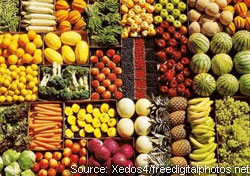
The desire to be fit and trim can often falter due to the
pressure of cooking healthy meals and the false assumption that nutritious
eating means tasteless food. It's actually quite easy to prepare healthy and
delicious dishes without depriving yourself the experience of enjoying your
food.
Read on for some useful tips and suggestions for cooking healthy,
low-calories meals for your and your family.
Use healthy methods
Frying or sautéing your foods in butter,
margarine, or oils high in saturated fats can add significant calories to your
meal. Instead, opt for broiling, baking, grilling, or steaming to avoid excess
added fats. Additionally, grilling or broiling meats further eliminates fat
because drippings fall away from the meat while it cooks. Refrain from adding
breading or other starchy coatings and season your food with citrus, herbs, or
broth.
Sauté the healthy way
If you do choose to sauté your meat, fish,
or veggies in a pan, use no-calorie cooking sprays to prevent sticking.
Vegetable broth can also be used to keep the food moist and add flavor. If you
do use cooking oils, opt for those with healthy fats such as olive or coconut
oil and always use them in moderation.
Portion control
Keeping your servings small is important when
maintaining a healthy diet. When following recipes, make sure to accurately
divide the suggested measurements to prepare the correct amount of food-this
will prevent you from the temptation of over-eating. Cooking your food for the
week and portioning your meals in advance is also a common tactic for healthy
eaters to keep their meal consumption consistent. Purchasing a small scale and
weighing your meals (a five-ounce piece of meat) and using measuring cups to
portion out sides (two cups of veggies) is useful as well.
Use lean meats
The fat and calories in your meal will greatly
vary on the type and cut of meat you are preparing. Chicken and turkey breasts
or fresh fish are always good choices. If you're a red meat lover, beef cuts
with the words "round" or "loin" in the name are leaner and come from a less
fatty pat of the cow. Tenderloin, top loin, sirloin and ground round are good
choice for lean beef cuts. Be sure to choose meat that is between 90 to 95
percent lean to keep your fat intake low-you can find this information printed
on most meat packaging.
Go skinless and trim fat
Always trim visible fat from your meat
and poultry to keep it lean. The skin on chicken and turkey contains the
majority of the meat's fat and calories, so buy skinless breasts or remove the
skin before eating.
Flavor with citrus
Citrus fruits like lemon, lime, or orange
offer a tangy yet sweet zest to any dish--a small spritz provides a robust
flavor while only adding minimal extra calories. Sprinkle on broiled chicken
breasts or fish instead of butter or oil, squeeze onto fresh veggies, or drizzle
over a salad in place of fatty dressings. The light, aromatic flavor is
versatile and can help you create numerous delicious and nutritious meals -
even on a budget.
Add extra herbs
If eating healthy sounds dull and tasteless to
you, you just need to get more creative! Creamy sauces and buttery toppings are
not the only ways to add rich flavor to your meal. Herbs are virtually
calorie-free flavor-enhancers and can spice up the drabbest of dishes.
Experiment with a variety of recipes and find out what your favorites are. Keep
dried staples in your pantry for frequent use and purchase
fresh herbs when a specific recipe calls for it. Remember, fresh and dried herbs
can't always be used interchangeably-they sometimes vary greatly in flavor
intensity and could
negatively alter the outcome of your meal.
Be smart with cheese
While dairy products can be high in fat,
you don't have to completely eliminate them from your daily diet. Choose lower
fat, lower calories options and substitute when you can. Cheeses like feta and
parmesan are lower in fat and calories, and have strong, pungent flavors that
allow you to use less. Cottage cheese is also a low fat, high-protein option,
and can be used as a substitute in recipes that call for similarly-textured
cheeses, such as ricotta.

Double your veggies
If you fear healthy eating will leave you
starved, double up on your servings of veggies. Veggies can be filling and are
extremely low in fat and calories, so they make the perfect side to any protein
at dinner, give lunch-time salads their bulk, and can be added to eggs for a
satisfying breakfast. Remember to opt for green, non-starchy vegetables like
leafy greens, broccoli or asparagus for maximum benefits to your waistline.
Beans are great as well-they are very filling and add protein and fiber.